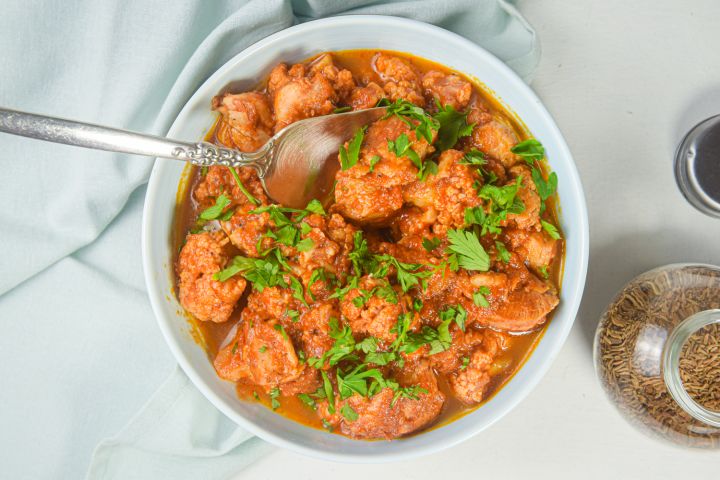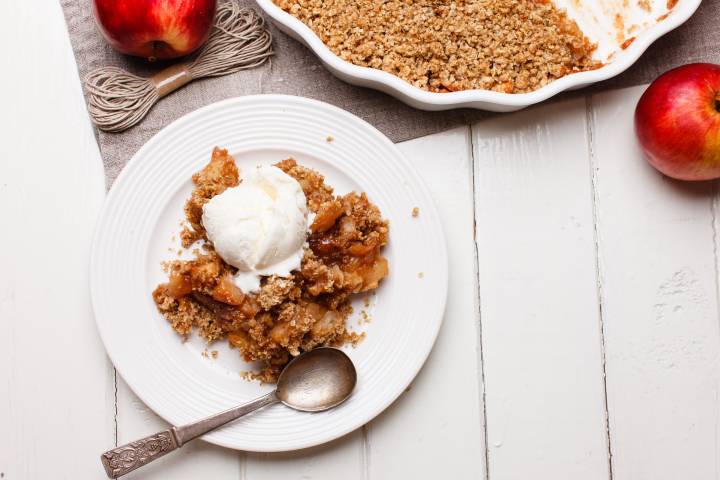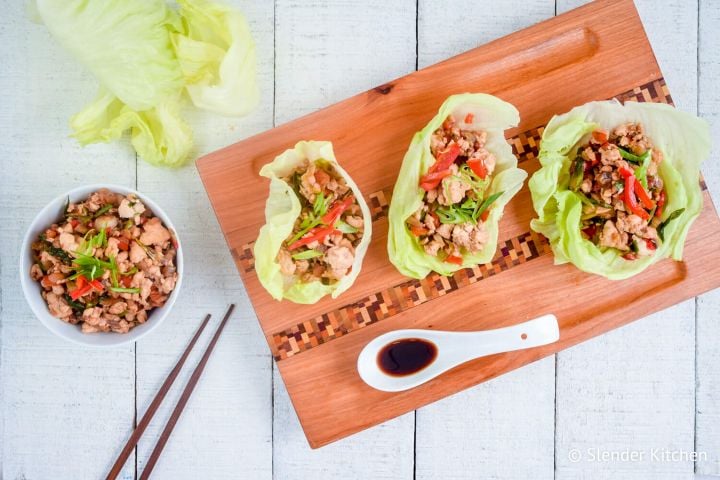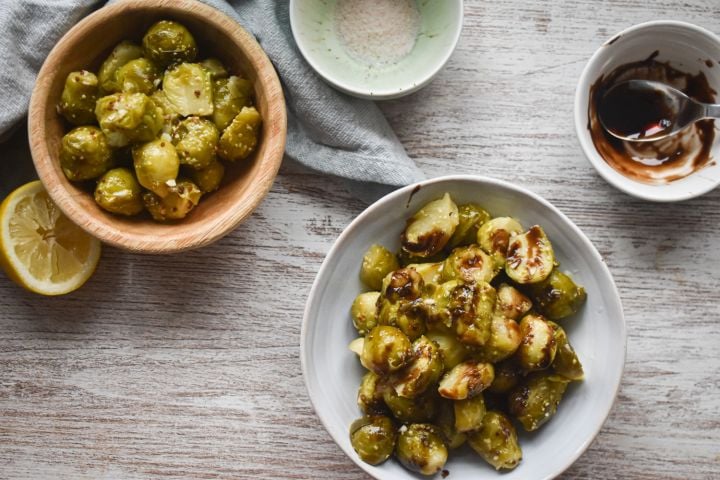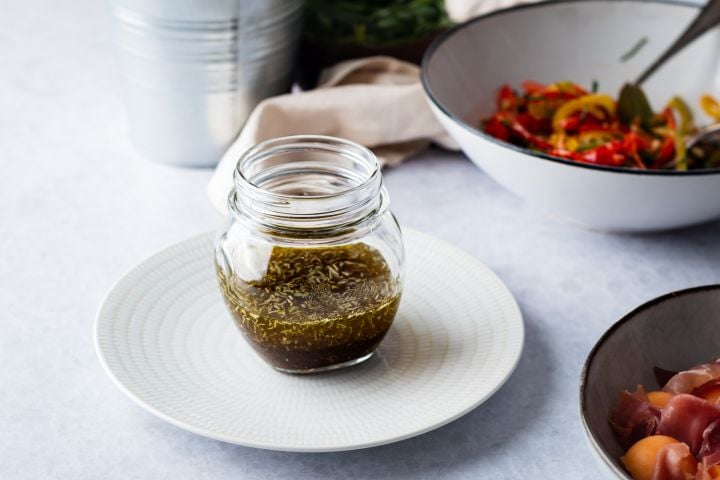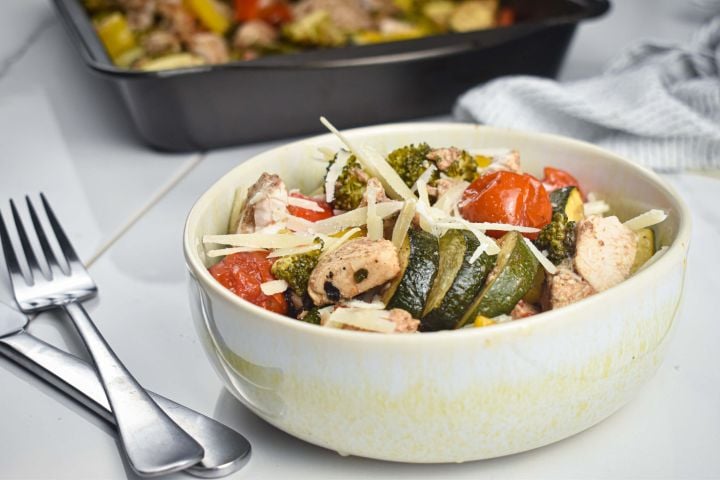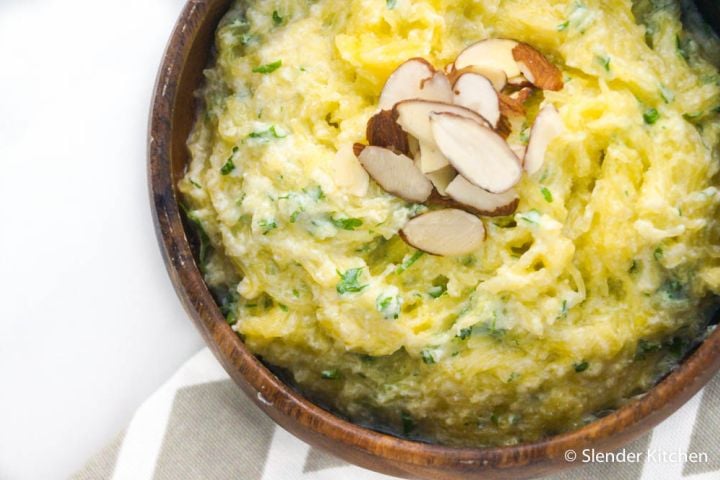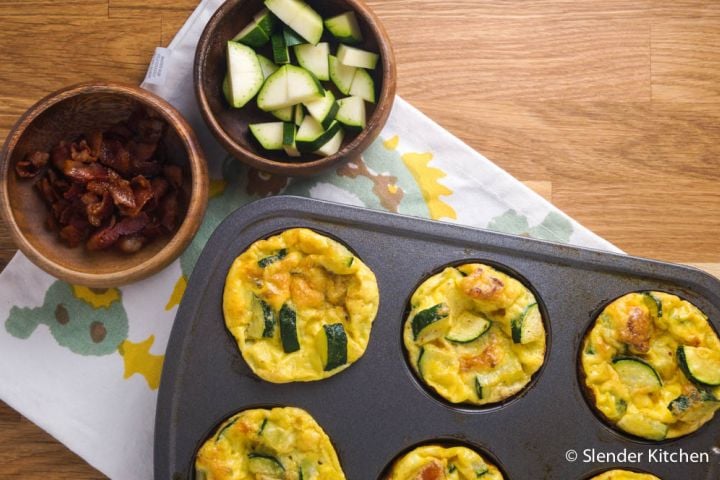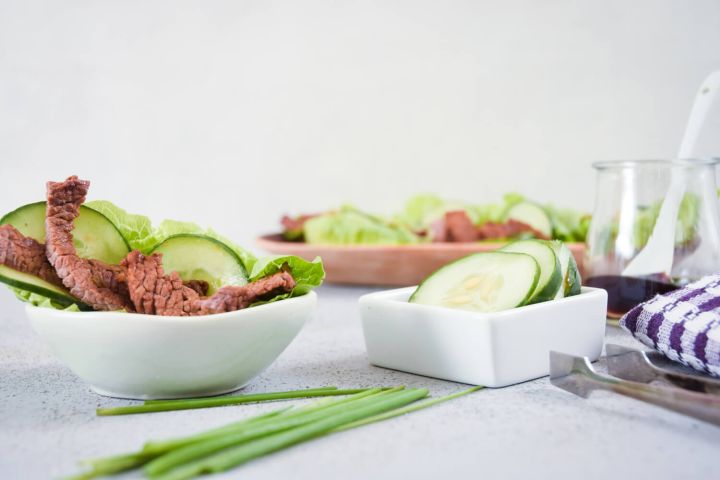Classic Wedge Salad with Creamy Yogurt Blue Cheese Dressing
Classic wedge salad with creamy yogurt blue cheese dressing, crispy bacon, tomatoes, and red onions.
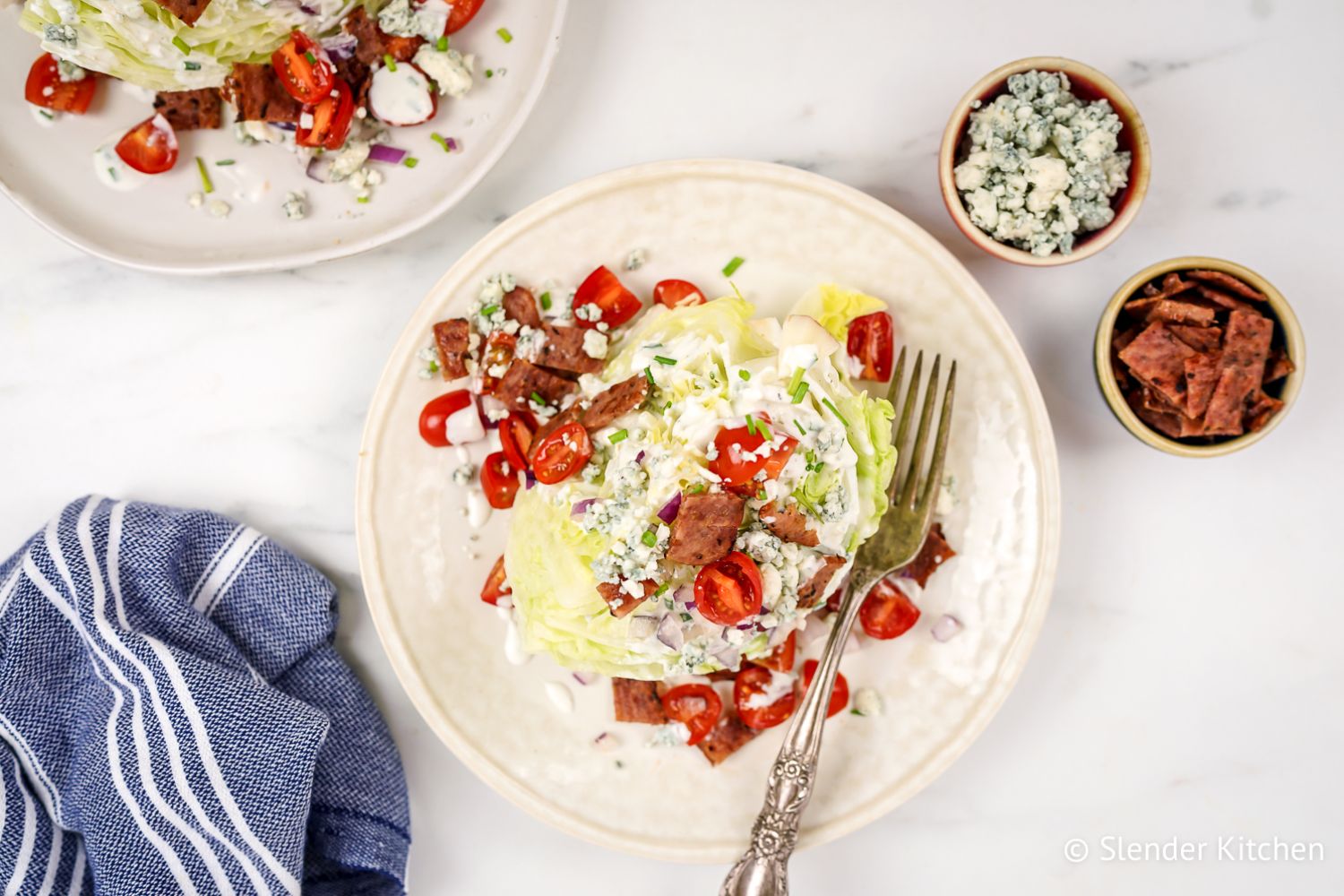
The classic Wedge Salad made healthier with a lightened-up homemade blue cheese dressing made with Stonyfield Yogurt. This post is brought to you by Stonyfield but all opinions are 100% mine.
There are two types of salads in the world - the ones that are actually good for you and the ones are seriously indulgent and just happen to have some vegetables. For the longest time, I classified the wedge salad as the latter. Super delicious but not winning any contests when it comes to nutritional content.
That all changes today. Using organic Stonyfield yogurt as the base for a healthier blue cheese dressing and pairing it with turkey bacon, cherry tomatoes, red onions, and lettuce - you can make a healthier version of this classic steakhouse salad that still tastes incredible.
Now to be fair, I still used iceberg lettuce for this salad. It’s just hard to pass up the super crispy Iceberg wedge. But if you wanted to amp up the nutrients and health factor, you could reach for something like Romaine, baby spinach, or spring greens instead.
My Trip with Stonyfield
A few weeks ago, I had the opportunity to visit Vermont with Stonyfield. Since Stonyfield is a product we love, my kids are obsessed with their smoothies and yogurt pouches, I jumped at the chance. During the trip, we would visit three of their organic farms and spend time with their team learning about their mission and commitment to organic farming.
I love learning about where my food comes from, so I was excited to take a look behind the curtains. Plus a few days of beautiful New England landscapes, incredible meals, and some truly amazing company sounded like the perfect way to spend a few days.
Little did I know, this trip would completely change the way I think about what it means to buy organic. It’s actually hard to put into words just how much this short 3 day trip impacted the way I think about food, where it comes from, and what that means for our bodies, communities, and the environment.
What does organic really mean?
Let’s start at the beginning. In the past, I never thought too much about buying organic. It just wasn’t a priority and honestly seemed too expensive. Then I had kids and started buying organic for them. And it was all about the “No’s,” - no pesticides, no antibiotics, no growth hormones. I didn’t want them exposed to toxic chemicals or unnecessary antibiotics, so I tried to buy organic when I could. But honestly, when it didn’t happen, I didn’t think twice about it.
Now that’s all changed.
The truth is that before this trip, buying organic was something I felt like I should do for my kids, but I had no idea what buying and eating organic really meant. It goes so far beyond just feeding our bodies better food and being healthier, it’s also about the farmers, our communities, and our planet.
Why organic is better for our bodies
There is a growing body of evidence that shows that eating organic is better for our health and in fact, can be one of the best things people can do when it comes to preventive health. When you feed your family organic food, it guarantees that your food is free from:
- Synthetic fertilizers to add nutrients to the soil
- Sewage sludge as fertilizer
- Most synthetic pesticides for pest control
- Irradiation to preserve food or to eliminate disease or pests
- Genetic engineering used to improve disease or pest resistance or to improve crop yields
- Antibiotics or growth hormones for livestock
Additionally, science is beginning to tell us that organic foods are also better for you from a nutritional perspective. For example, studies show that organic milk is more nutritious than its conventional counterpart. Organic cows that spend a significant part of their time on pastures (which is part of the organic standard) produce milk that is higher in heart healthy Omega 3 fatty acids and CLAs.
To sum it up, less bad stuff and more good stuff. For me, that alone is a pretty compelling reason to try and eat organic. But it actually goes deeper.
How eating organic helps farmers
One of the most amazing parts of this trip, was getting the chance to visit some of the organic dairy farms that provide Stonyfield with their milk. Specifically, we spent time with two farmers, Julie and Greg, and had the chance to visit their farms, meet their herds, and speak candidly with them about why they made the switch from conventional dairy to organic.
Both Greg and Julie started as conventional dairy farmers and switched to organic. Initially, they switched for financial reasons since organic milk demands a higher premium (organic farms are 35% more profitable on average) but both have seen the impact that organic farming practices has had on their cows. Their animals are healthier, happier, and living longer.
When we choose to buy organic, we can help provide small family farms with a more sustainable way to support their families. Learn more here.
Eating organic and the environment
Would you be surprised to learn that it’s estimated that converting all of America’s cropland to organic would have the same carbon-reducing effect as taking 217 million cars off the road. The fact is that organic farming practices actually help the environment.
Organic farming practices can be part of the solution when it comes to climate change. Organic farmers use natural practices like crop rotation, cover crops, and beneficial insects to manage their feed and farms. These practices build soil that helps sequester carbon, meaning it can actually help remove extra carbon from the environment. With the right practices, farming can become part of the solution instead of the problem.
This is in addition to the fact that organic farming doesn’t rely on toxic pesticides and chemicals that often pollute the air, water, and land in and around farms. No worries about toxic runoff, contaminated water, and land and air pollution from pesticides.
Now, what?
For me, this trip was such an eye opener. It’s totally changed the way I think about what buying organic means. It means that whenever possible, I will be buying organic products.
With that said, I know that buying organic isn’t always an option for everyone because let’s be honest, organic can be significantly more expensive. In that case, buy organic when you can.
Start with products where the price for organic is only slightly more - think oatmeal or carrots. Stock up on organic products like meat, poultry, grains, and frozen fruits and veggies when they are on sale. Consider shopping at farmer’s markets or natural food stores with bulk bins. With some creativity, organic can be more affordable.


Classic Wedge Salad with Creamy Yogurt Blue Cheese Dressing
- Download
- Send to your inbox
Ingredients
-
2/3 cup Stonyfield whole milk plain yogurt
-
2 tbsp crumbled blue cheese
-
2 tbsp mayonnaise
-
1 tbsp chives
-
1/2 tbsp white vinegar (or lemon juice)
-
1/2 tsp garlic powder
-
Salt and pepper
-
1 head iceberg lettuce
-
4 slices turkey bacon, cooked until crispy
-
1 cup cherry tomatoes, quartered
-
1/4 cup red onion, diced
Instructions
(Hide Media)Switch to prevent your screen from going dark.
* Percent Daily Values are based on a 2,000 calorie diet. Your daily values may be higher or lower depending on your calorie needs.
The Nutritional Values provided are estimates only and may vary based on the preparation method.

Get delicious, healthy recipes delivered each week right to your inbox.

Snap a picture and show us what you made on Instagram or Facebook.
Tag us using @SlenderKitchen or #slenderkitchen.






